For those who work with hand tools, pliers might seem like the catch-all phrase. There are numerous types of pliers. The general design of pliers consists of two handles, a pivot, and a head. They can cover a pretty broad range of applications, such as gripping, positioning, twisting, cutting, tightening, or loosening various objects.
To help you gain a broad perspective on pliers, Linquip provides you with a wealth of information. On our “Tools and Instruments” webpage, you can find out exactly what Linquip can do for you based on your intended use. You can learn about pliers now so that you can do your job more efficiently.
Have a hard time choosing the right plier for your application? Linquip offers a variety of Tools and Instruments Products, and we can help you find the right tool. By using Linquip’s online form, you can obtain quotes from a wide variety of Tools and Instruments Suppliers and Companies in a short period of time.
Plier use increases productivity in DIY tasks as well as professional operations. Even though pliers are an essential tool you should keep in your toolbox, if you choose the wrong pliers, you may not be able to accomplish the task. For instance, when you attempt to cut a wire, using pliers that do not have a cutting function makes no sense. The purpose of each pair of pliers varies, so it’s important to select pliers accordingly.
Various types of pliers are available, some with multiple functions, while others are exclusively designed to handle one particular application. The purpose of this article is to provide you with an introduction to the most commonly used pliers when doing all kinds of technical tasks.
A Brief Overview of Pliers
A plier is a multi-purpose hand tool that has opposing grips for holding, bending, and biting. It also has two cross-metal parts that give the user hard levitation, thereby improving their hand strength. Pliers should be included in every toolbox, as they have many uses around the house.
All-purpose pliers can usually accomplish the task, but there are also pliers that work well for specific tasks. Find out which pair of pliers is right for the job and improve efficiency.
There are a number of applications for pliers, including:
- Entertaining
- Bending and straightening
- Cutting
- Stripping insulation and splicing wire
Pliers: Parts and Function

Pliers consist of only a few parts, but all of these parts perform important functions. Without these features, pliers could not perform their primary function.
Jaws (Nose)
These are the working ends of the pliers. Their primary purpose is to grip. Some pliers contain jaws as well as a pipe grip and/or a cutter.
Fulcrum (Pivot Points)
As well as connecting the jaws and handles, this is the point at which the pliers’ jaws create the force needed to operate.
Pipe Grips
An oval or round opening in the jaw makes it possible to grip pipes, cups, and other round objects.
Handles
It can be straight or curved, and its surface can be coated with plastic or bare metal, depending on the type of pliers.
Cutters
In some pliers, the cutters are located near the fulcrum of the tool. These pliers are designed for cutting wire and metal.
Types of Pliers
There is a high probability that you have used or seen these pliers before. They are available just about anywhere and can often be used for a variety of different things. Most people have at least one in their tool chest or hand.
Crimping Pliers
Known as crimping tools, these tools are used much like nutcrackers. You feed wires into the jaw’s jack and then connect them with connectors. Using the handles, you can break through the plastic coatings and create crimps or deformations in the sections.

Most of them are applied in telecommunications and networking. Terminal crimpers are widely employed in automobiles, and R145s are commonly used in computers.
Diagonal Pliers
As well as flush-cut pliers and wire cutters, these tools can also be referred to as diagonal pliers and wire cutters. The jaws of these pliers are angled to cut thick wires as well as nails. They are used in the electrical industry and in the carpentry industry.
Hose Clamp Pliers
They are also known as radiator hose pliers, spring clamp pliers, and hose pliers. They are used in order to tighten spring and hose clamp connections. Most models feature peg-shaped teeth on each jaw, which are used to pinch the clamp. Some models may also be used directly on hoses.
Needle Nose Pliers
The nose of these pliers is elongated for added precision, and it contains a cutting edge near the base. They can be used to shape, cut, and bend the wire. They are found in the majority of home toolboxes and are used in a wide range of trades, such as electrical engineering, jewelry making, fishing, and networking.
Bent Nose Pliers
These are another type of needle nose pliers. They have an angled jaw at the midpoint, usually 45 or 90 degrees, and they can grip onto surfaces without getting in the way when you need more than one. When you can’t reach an angle with needle nose pliers, this is also useful.
Wire shaping is one of their most useful uses, whether it be electrical work, jewelry making, or something else.
Slip Joint Pliers
Also called water pump pliers, these pliers feature an adjustable fulcrum that can adjust their jaw width. They are similar to adjustable wrenches.
Many of the variants have notches for the bolt to slide into when the pliers’ jaws are open, so you can lock on a specific width. The most common application for them is in plumbing.
Snap Ring Pliers
C-clip pliers, retaining ring pliers, lock ring pliers, and circlip pliers are also common names for these tools. These types of pliers have round, short jaws that help close snap rings and open-ended loops that fit into rounded objects like dowels.
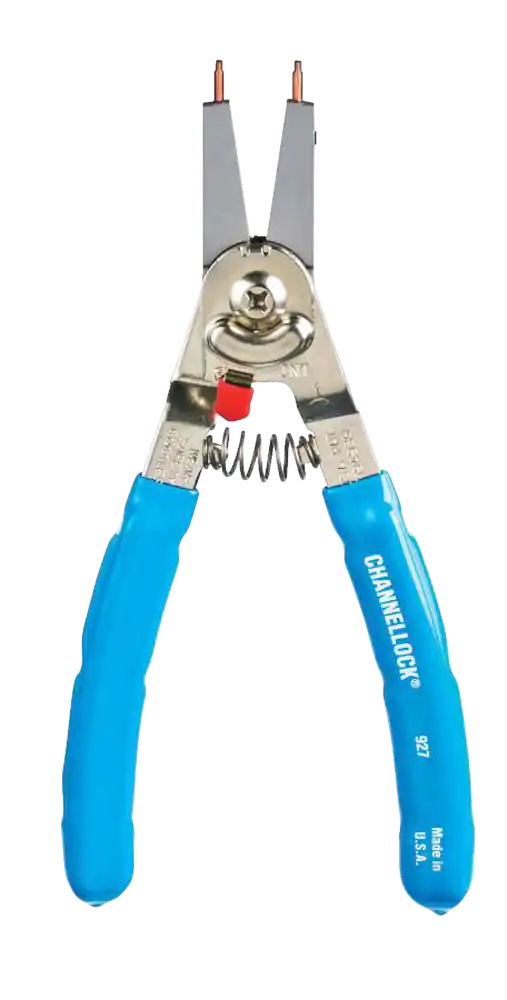
The ring can rotate freely once it’s closed, but it can’t move sideways. They’re often used on mountain bikes and other vehicles.
Tongue & Groove Pliers
These pliers, also known as channel locks, have teethed grooves along their upper handles, allowing them to be adjusted in a variety of positions. They can also be used to turn bolts and nuts.
Bail Making Pliers
Generally used for making jewelry, this tool has jaws that have two dowels, one of which is larger than the other. A loop component, such as an ear wire or clasp, is formed by winding wire around the jaws of these tools.
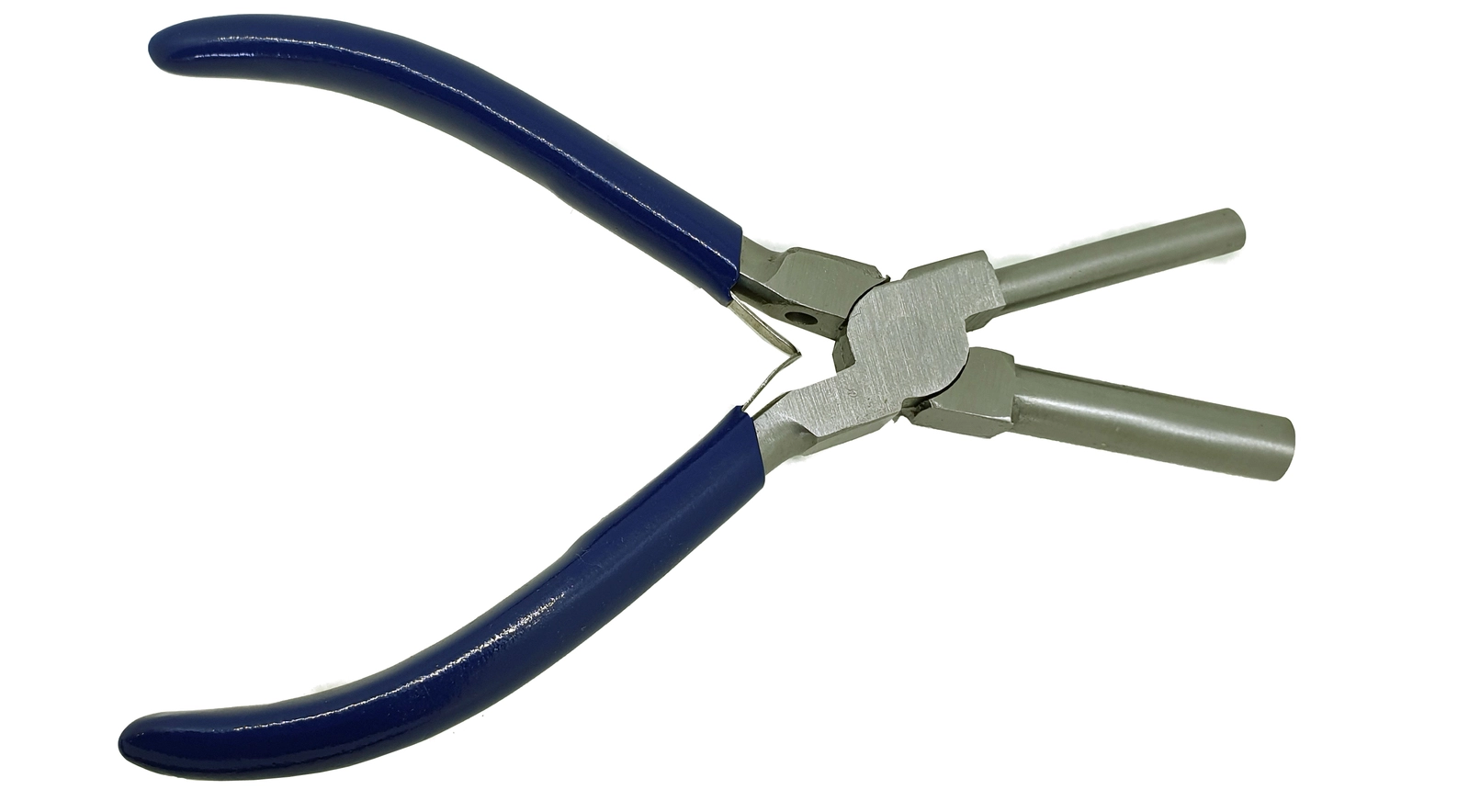
Battery Pliers
In automotive applications, these pliers are primarily used to maintain jumper cables, car batteries, and bolts on jumper cables. The lower jaw is smaller, and both jaws are thick for greater durability.
Brake Spring Pliers
As another tool used in automotive, these are specifically designed to handle drum brake springs. One of the jaw tips is rounded for removing the springs and the other for reinstalling them. A ratchet may also be attached to one handle to remove shoe hold-down pins.
Canvas Pliers
A canvas stretching plier is a tool used by artists and allows them to do things that usually require two people. Their jaws are usually padded to prevent damage to the surface of the canvas as they stretch it into place.
Chain Nose Pliers
This is a plier type with stubby triangular jaws and is designed for shaping, bending, and crimping wire; these pliers are used in jewelry-making and wire shaping.
The tips of these tools are useful when making beaded jewelry as they help you open and close jump rings as well as bead tips.
Combination Pliers
With combination pliers, you get three sections in one tool. From the tip, there’s a serrated surface for gripping. There is a serrated surface behind that, which is useful for gripping thick, round objects. Finally, the closest section to the pliers’ fulcrum is the cutting surface. Many people mistake them for lineman pliers, but they don’t have those rounded jaws.
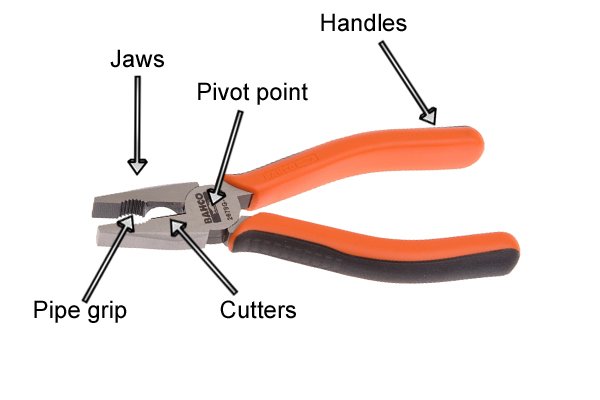
Eyelet Pliers
The clothing industry uses these pliers to tailor and assemble clothing. Eyelets allow drawstrings and laces to be attached to clothing through elongated hubs and rings that need to be crimped.
There are many modern eyelet pliers that come with interchangeable dies that can be used both for punching and crimping, even though some only have a surface for crimping or a wheel with die tips in their upper jaws.
Grommet Pliers
Their function and form are similar to eyelet pliers, and they are used to create holes in materials such as tarps and to attach grommets. When compared to eyelets, grommets are much more durable, which makes these pliers ideal for crafts involving sturdy materials.
Fencing Pliers
When viewed from above, this tool appears like a hammer with two handles. The fulcrum of the tool has notches that allow you to cut wire securely, whereas the left jaw has a hammer surface for driving staples. There are rounded grip holes and gripping surfaces on the jaws, which are useful for removing staples from the right jaw.
Flat Nose Pliers
It’s a tool that is commonly used in mechanical and electrical work to twist and grip metal, as well as to twist wires and leads. It’s also called duckbill pliers. With their long and short noses, they can make sharp bends and right angles using wire.
Hose Grip Pliers
In addition to being called grabber pliers, these are specifically designed pliers that are designed to get small hoses out of or into tight places with ease. Fuel lines, heater hoses, and vacuum lines are some of the things they are used for, as they have grabber jaws that protect them from getting damaged.
You can use it to remove spark plugs, clamps, and a variety of other items by simply gripping the hose and twisting it off or on.
Linesman Pliers
Despite their name sounding unfamiliar, it’s likely you’ve used or seen them before. Their jaws are easy to recognize, and they have a gripping surface near the tip and a cutting surface in the middle. As a versatile tool, it’s often used when performing electrical work.
It is also possible to bend and twist metal with these pliers, which is not possible with other kinds. In some cases, insulated handles can prevent users from getting shocks.
Locking Pliers
Known also as vice grips, these pliers have jaws that are designed to lock, so they are ideal for gripping bolts or screws that have been stripped. Various jaw shapes are available, so you can find the design that suits your needs best.
Nail Puller Pliers
A pair of these looks like a pair of tongs, and they have tapered tips. Their tapered tips make them easier to dig beneath a nail’s head and pull it out. Some varieties even have claws on their right jaw, allowing them to be more powerful.
Oil Filter Pliers
This type of plier looks strange. Its toothed jaws are C-shaped, while one is much longer than the other. It is used in the automotive industry to remove oil filter casings.
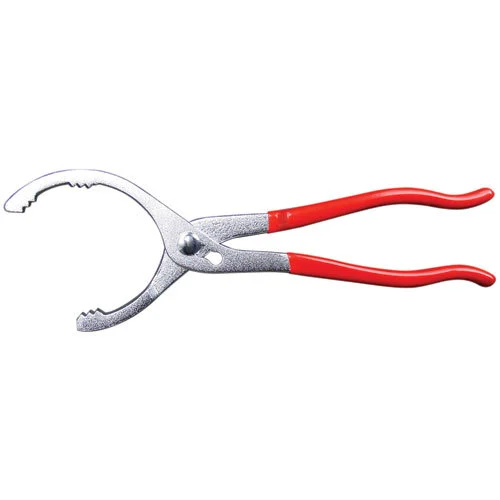
Piston Ring Pliers
Two main types of these pliers are available, and both are used to remove or replace piston rings within engines. The first type has curved jaw tips meant for spreading piston rings so they can be removed more easily.
Alternatively, there are models that have jaws that are much larger and a few braces that support the ring to prevent warping.
Push Pin Pliers
A wedge-shaped jaw tip makes it possible to get beneath the pin caps of plastic anchors. By squeezing the pliers, a push pin pops out, allowing anchors to be safely removed. In addition to automotive work, these anchors are used in a wide range of other industries.
Round Nose Pliers
They are known as rosary pliers or jewelry pliers. Their jaws are rounded and slightly tapered, and the jaws are shaped into a triangular design. The handles of some of these tools are insulated to withstand electrical activity. They’re used to make jewelry loops, especially rosaries.
Running Pliers
Crafts involving stained windows use these tools, and they break glass cleanly along a scored line. They have wide-tipped jaws and are adjustable to match the thickness of the glass. You can align them along your score with their center lines to ensure the right alignment.
Sheet Metal Pliers
Also known as seamer pliers, these are pliers that have rectangular and wide jaws that are excellent for bending sheet metal and forming seams. Their use is prevalent in industries that work with sheet metal, such as metal shops.
Split Ring Pliers
A fisherman uses these pliers, often called fishing pliers. They are similar to stubby chain nose pliers or needle nose pliers, but their lower jaw is hooked, which serves as a wedge for splitting apart coiled rings. Split rings are often used by fishermen for constructing fishing tackle and keychains.
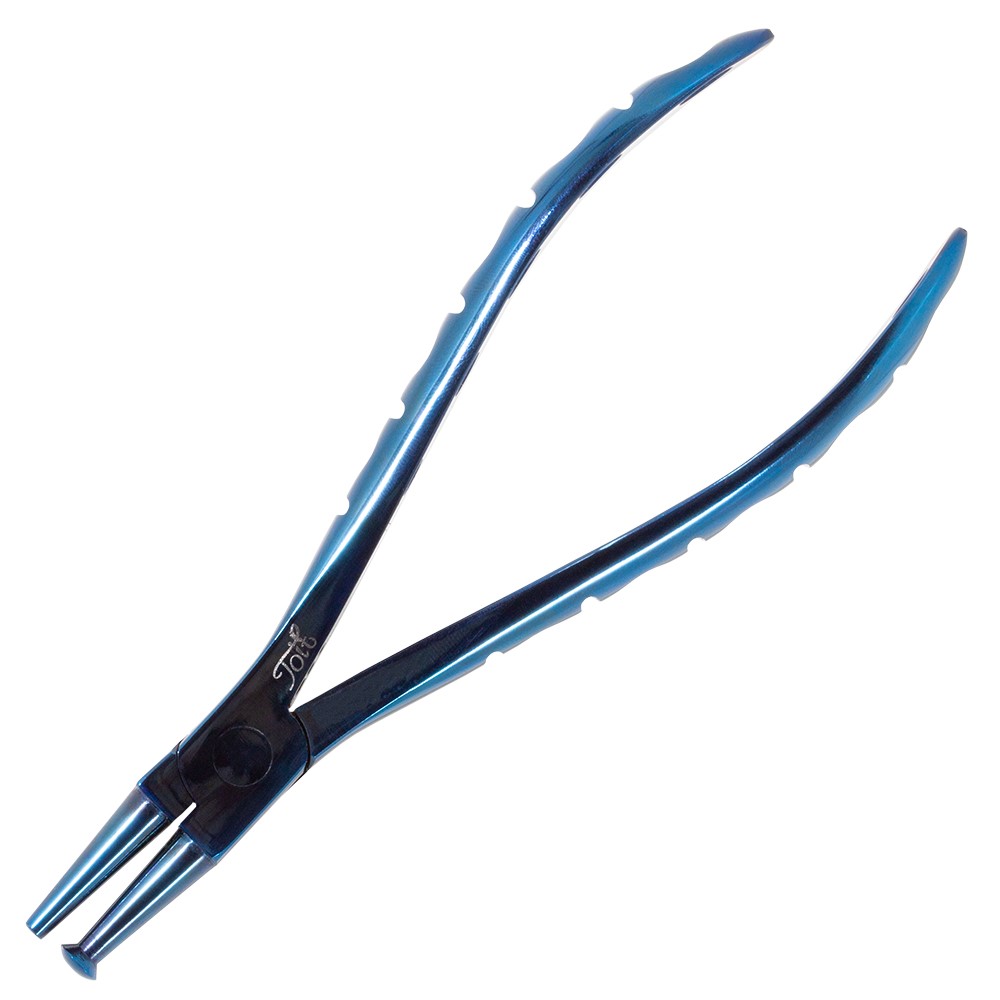
Soft Jaw Pliers
The jaws on these pliers are padded so that damages on exposed surfaces or soft metals are not caused by scratches. They are commonly used for scuba diving and plumbing equipment, and they include a wide variety of types of pliers.
Spark Plug Pliers
With narrow jaws, these pliers are either equipped with cylindrical tongs or insulated tong tips. They grip spark plugs by wire or boot during automotive repairs.
Welding Pliers
The jaws of welding pliers resemble those of combination pliers, and they have the same tip as needle nose pliers. The tool does a lot of jobs, including gripping wire, hammering, and cleaning up spatter. As the name implies, they’re frequently used in welding.
Wire Twisting Pliers
This pair of pliers has rather unusual features. It has short jaws and a cutting edge at the fulcrum. It has a threaded knob between its handles and a cylindrical locking mechanism.
The wire will twist with the tool when you lock it into place and pull back the knob. Jewelry makers and electricians often use them, as well.
Conclusion
In general, pliers are tools that are used all over the world. Probably you won’t use one of them, but you now know what pliers are!
Download PDF for Types of Pliers
Here is a link where you can download the PDF version of the article for your future reference and reading.
Buy Equipment or Ask for a Service
By using Linquip RFQ Service, you can expect to receive quotations from various suppliers across multiple industries and regions.
Click Here to Request a Quotation From Suppliers and Service Providers
Read More on Linquip
- 27 Types of Screwdrivers + Names (Comprehensive Guide)
- 12 Types of Industrial Sewing Machine + Advantages
- 5 Different Types of Drill Bits for Wood: A Comprehensive Guide
- Types of Drill Bits for Metal: Comprehensive Guide
- The 8 Best Pliers of 2023 + Buying Guide
- 17 Types of Hinges and Hinge Materials: A Complete Guide
- 9 Types of Blind Rivets + Working Principle & Applications
- Types of Electrical Wire + Application (Complete Guide)
- The 10 Best Rivet Tool in 2023
- 10 Types of 3D Printing: A Comprehensive Guide
- 3 Types of Magnets + Name & Applications
- 4 Types of Solid Rivets + Working Principle
- 9 Types of Pop Rivet + Working Principle (Clear Guide)
- 7 Types of Solder + Working Principle & PDF
- 13 Types of Rivets + Applications & Working Principle
- 16 Types of Scaffolding + Components & PDF
- 28 Types of Clamps: A Complete Guide
- How Springs Are Made? 5 Fundamental Steps (Clear Guide)
- 18 Types of Machining Vises (Clear Guide)
- 8 Types of O-Ring + Applications (Clear Guide)
- The 8 Best Pliers of 2023 + Buying Guide
- All 24 Types of Drill Bits + Video: Clear Guide
- Different Types of Bolt Heads + Benefit of Bolts and Nuts
- Different 5 Types of Fasteners: A Practical Guide



